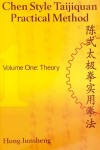6.b.xiii.-chen-style-taijiquan-practical-method-vo Section
Chen Style Taijiquan Practical Method - Vol 1 Theory
Author: Hong Junshen
Paperback:157 pages
Author: Hong Junshen
Publisher: Hunyuan Taiji Press (2006)
Translator: Chen Zhonghua
ISBN-10: 097300455X
Reviewer: Nick Gudge (Dec 2011)
 This book is a translation of a Chinese language book, written over 25 years and finally completed in 1988. It was translated by Chen Zhonghua. In his acknowledgement the translators says “Hong’s book is profoundly difficult to translate” and “I find many insurmountable barriers in converting language, cultural belief and technical points into the English language.” This difficulty is evident in the result.
This book is a translation of a Chinese language book, written over 25 years and finally completed in 1988. It was translated by Chen Zhonghua. In his acknowledgement the translators says “Hong’s book is profoundly difficult to translate” and “I find many insurmountable barriers in converting language, cultural belief and technical points into the English language.” This difficulty is evident in the result.
Despite the obvious adulation of the translator for his teacher, Hong Junshen may have been a person of considerable taijiquan skill. As the title suggests this is a book about taijiquan theory. The question is not about whether he understood taijiquan but whether he was sufficiently skilled a communicator to convey his understanding of taijiquan theory in writing. Based on this translation I would suggest that he was not able to do this. How much of this is a failure in translation I cannot tell.
The book consists 5 sections. The first is 26 pages of “Introduction” where an effort is made to explain the principles and problems of taijiquan. The main body of the book is written in ‘poetic’ form. There are two section, one of 12 verses and the other of 13 which attempt to both explain and presumably convey Hong Junshen’s poetic ability. I find neither effort to be very successful. The content of the poems is occasionally informing, sometimes intriguing but most frequently obtuse. The English language used, the choice of words in my opinion is not conducive to helping the reader find understanding. The text in the first poem offers us that taijiquan is “a perfect art form”, with “a precise theory.” Students should “follow the rules strictly” and that the first rule is the “requirement to be solemn.”
The fourth section is also poetic, with 22 poetic styled treaties on taijiquan, each with a commentary. Again these poems and commentaries have a strong tendency towards the esoteric and abstruse. They are not overly helpful to either the general reader or the serious student in my opinion.
My favourite part of this book was Section 5 – Memoir of Learning, a short compilation of Hong Junshen’s memories of his teacher Chen Fake. Although I had heard all these stories before, nevertheless I found it valuable to hear of them from someone who was there when they occurred.
Ratings: Overall: 4.75 out of 10
Content: 4 out of 10 Language: 5 out of 10 Accuracy: 7 out of 10 Helpfulness: 3 out of 10
